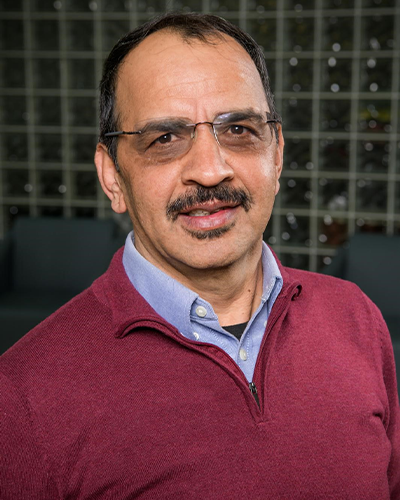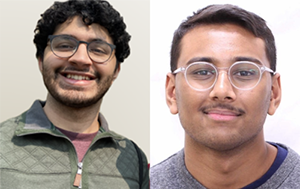![]()
 Girish Melkani, Ph.D.Girish Melkani, Ph.D., associate professor of medicine in the Department of Pathology's Division of Molecular and Cellular Pathology, is the latest recipient of the Heersink School of Medicine’s Featured Discovery. This honor recognizes significant research contributions by Heersink faculty.
Girish Melkani, Ph.D.Girish Melkani, Ph.D., associate professor of medicine in the Department of Pathology's Division of Molecular and Cellular Pathology, is the latest recipient of the Heersink School of Medicine’s Featured Discovery. This honor recognizes significant research contributions by Heersink faculty.
Melkani's study, “Automated assessment of cardiac dynamics in aging and dilated cardiomyopathy Drosophila models using machine learning,” was published in Communications Biology (A Nature Portfolio Journal).
Melkani and his team, “harnessed cutting-edge deep learning technologies to study the hearts of Drosophila (commonly known as fruit flies), uncovering new insights into heart aging and disease. Through this innovative approach, they developed an efficient, automated system to quantify key heart parameters, such as heart rate and cardiac performance, during aging and under pathological conditions like dilated cardiomyopathy.”
“We also present a remarkable deep-learning model which is able to identify aging related disfunction in cardiac recordings with around 83% accuracy” explains Melkani. “This exciting approach could revolutionize heart disease research and offer valuable clues for understanding similar conditions in both animals and humans.”
 Yash Melkani and Aniket PantWe asked the team, including Yash Melkani, who recently acquired an engineering degree from UC Berkeley and researcher at UAB, and Aniket Pant, who recently acquired an engineering degree from Georgia Tech and researcher at UAB, when they realized they had made an important discovery. Melkani said, “When my young engineering team successfully trained a neural network with several dozen Drosophila hearts, they obtained remarkable results. Yash Melkani, remarked, 'It was fascinating to see our machine learning models grasp the intricate details of Drosophila cardiac physiology.' He added, 'This was my first experience applying machine learning models in vivo, and I’m thrilled with the successful outcome.' Aniket Pant expressed, 'It was exciting to see how modern deep learning could be applied to study cardiac health in alternative heart models. I hope this innovative work will enable next-generation high-throughput analysis of Drosophila models, advancing future research in cardiac health and aging.'"
Yash Melkani and Aniket PantWe asked the team, including Yash Melkani, who recently acquired an engineering degree from UC Berkeley and researcher at UAB, and Aniket Pant, who recently acquired an engineering degree from Georgia Tech and researcher at UAB, when they realized they had made an important discovery. Melkani said, “When my young engineering team successfully trained a neural network with several dozen Drosophila hearts, they obtained remarkable results. Yash Melkani, remarked, 'It was fascinating to see our machine learning models grasp the intricate details of Drosophila cardiac physiology.' He added, 'This was my first experience applying machine learning models in vivo, and I’m thrilled with the successful outcome.' Aniket Pant expressed, 'It was exciting to see how modern deep learning could be applied to study cardiac health in alternative heart models. I hope this innovative work will enable next-generation high-throughput analysis of Drosophila models, advancing future research in cardiac health and aging.'"
The Heersink communications team met with Melkani to learn more and spread awareness about the study and the Heersink School of Medicine.
Q. What compelled you to pursue this research?
With a little background in machine learning, I am still deeply fascinated by its potential and eager to apply these techniques in my lab’s research projects. Drosophila models are widely used to study heart-related diseases and cardiac aging. Traditionally, quantifying heart function involves manually marking heart edges during contraction and relaxation—a labor-intensive process prone to human error. To address this, we’ve developed an innovative deep learning method that automates the analysis of Drosophila heart function, improving both efficiency and accuracy in studying cardiovascular diseases and aging. Several ongoing projects aim to fully automate this process, with the ultimate goal of replacing outdated manual methods to provide more reliable data with fewer errors.
Q. How do you feel your research will impact the science community? One of the key advantages of using Drosophila models is the ability to generate large datasets rapidly, enabling the screening of hundreds of genes in a short time. Additionally, many age-related and heart disease changes seen in humans can be modeled effectively in Drosophila. With the development of automated, deep-learning-based heart analysis methods, we are now able to explore how various genetic and environmental factors influence heart aging and pathology with greater precision. This ongoing project has the potential to be expanded to other models, such as zebrafish and mice, and can ultimately be adapted for human heart studies, offering significant insights into cardiac health and disease. As a result, the public relevance of this work is substantial.
Q. What is your research’s relevance to human disease?
These findings have significant human relevance, particularly for heart disease diagnosis and aging research. For example, the deep learning platform used to analyze Drosophila hearts could be adapted to process and quantify human echocardiography (echo) data, providing precise measurements of cardiac function in aging patients or those with conditions like dilated cardiomyopathy and other cardiomyopathies. By predicting heart dysfunction with high accuracy, similar models could assist clinicians in the early detection and monitoring of cardiac diseases, offering insights into human heart health and aiding in the development of personalized treatments.
Q. What do you think makes the science community here unique?
The vibrant scientific community at UAB provides valuable opportunities to discuss the various research areas my lab is pursuing. As outlined on my lab’s website, my group is at the forefront of using both in vivo models (Drosophila) and human studies to explore the pathophysiological basis of circadian and metabolic dysregulation associated with cardiometabolic disease, myofibrillar myopathies, proteinopathies, neuropathies, sleep disorders, and aging. By integrating machine learning and omics approaches with physiological, cell-molecular, genetic, genomic, and nutritional techniques, we aim to understand how lifestyle factors, such as circadian rhythms and time-restricted feeding, along with genetic factors, contribute to maintaining the structural integrity of cells, tissues, and organs, which in turn shape overall organismal physiology and behavior. I am fortunate to be able to discuss these diverse research projects across basic, translational, and clinical domains. In addition to external collaborations, I maintain around a dozen collaborative projects within UAB, spanning multiple departments.
Animated heart video demonstrates the output of the neural network
To read more about Melkani's study, click this link.